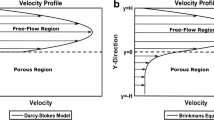Abstract
Both \(\hbox {CO}_{2}\) storage and disposal of waste fluid (e.g., co-produced brine) in deep saline aquifers of sedimentary basins create large scale over-pressurization and tend to displace brine upwards if a vertical connection (e.g., an abandoned well) is present. This raises groundwater pollution issues of brine intrusion into shallower potable water aquifers. When saline brine from the deep aquifer is displaced upwards it lifts and replaces the a priori less saline, less dense water initially filling the connection, resulting in a weight increase that counters leakage. This article presents and explains an innovative semi-analytical solution to this problem of leakage between two aquifers connected by a passive well (represented by a porous column and/or an open wellbore) taking account of the effect of the density difference between lifting and lifted brines during both upward and downward flow. It is based on the linearization of brine density profiles against depth and on two improvements made to the approximate evaluation of convolution products introduced in Nordbotten et al. (Water Resour Res 40:W04204, 2004) for calculation of the pressurization induced by transient flows in open aquifers. The comparison with numerical simulations shows good agreement of results. Since the solution uses time discretization but no spatial grid, computation time is reduced by 3–4 orders of magnitude compared to numerical resolution. It does, however, require considering homogeneous aquifers of constant thickness and brine properties.















Similar content being viewed by others
References
Audigane, P., Chiaberge, C., Mathurin, F., Lions, J., Picot-Colbeaux, G.: A work?ow for handling heterogeneous 3D models with the TOUGH2 family of codes: applications to numerical modeling of CO2 geological storage. Comput. Geosci. 37, 610–662 (2011)
Bandilla, K.W., Kraemer, S.R., Birkholzer, J.T.: Using semi-analytic solutions to approximate the area of potential impact for carbon dioxide injection. Int. J. Greenh. Gas Control 8, 196–204 (2012)
Battistelli, A., Calore, C., Pruess, K.: The simulator TOUGH2/EWASG for modeling geothermal reservoirs with brines and non-condensible gas. Geothermics 26(4), 437–464 (1997)
Birkholzer, J.T., Nicot, J.P., Oldensburg, C.M., Zhou, Q., Kraemer, S., Bandilla, K.: Brine flow up a well caused by pressure perturbation from geologic carbon sequestration: static and dynamic evaluations. Int. J. Greenh. Gas Control 5, 850–861 (2011)
Clark, J.E., Bonura, D. K., Van Voorhees, R.F.: An overview of injection well history in the United States of America. Dev. Water Sci. 52, 3–12 (2005)
De Marsily, G.: Quantitative Hydrogeology. Academic Press, Orlando (1986)
Dobossy, M.E., Celia, M.A., Nordbotten, J.M.: An efficient software framework for performing industrial risk assessment of leakage for geological storage of \(\text{ CO }_{2}\). Energy Procedia 4, 4207–4214 (2011)
Gasda, S., Bachu, S., Celia, M.A.: Spatial characterization of the location of potentially leaky wells penetrating a deep saline aquifer in a mature sedimentary basin. Environ. Geol. 46, 707–720 (2004)
Global CCS Institute (GCCSI): The Global Status of CCS: 2012, Canberra, Australia (2012)
Humez, P., Audigane, P., Lions, J., Chiaberge, C., Bellenfant, G.: Modeling of CO\(^{2}\) leakage up through an abandoned well from deep saline aquifer to shallow fresh groundwaters. Transp. Porous Media 90, 153–181 (2011)
Javandel, I., Tsang, C.F., Witherspoon, P., Morganwalp, D.: Hydrologic detection of abandoned wells for hazardous waste disposal. Water Resour. Res. 24(2), 261–270 (1988)
Mathias, S.A., Hardisty, P.E., Trudell, M.R., Zimmerman, R.W.: Approximate solutions for pressure buildup during CO\(^{2}\) injection in brine aquifers. Transp. Porous Media 79(2), 265–284 (2009)
Nicot, J.-P.: A survey of oil and gas wells in the Texas Gulf Coast, USA, and implications for geological sequestration of \(\text{ CO }_{2}\). Environ. Geol. 57, 1625–1638 (2009)
Nicot, J.-P., Oldenburg, C., Bryant, S., Hovorka, S.: Pressure perturbations from geologic carbon sequestration: area-of-review boundaries and borehole leakage driving forces. Energy Procedia 1, 47–54 (2009)
Nordbotten, J.M., Celia, M.A., Bachu, S.: Analytical solutions for leakage rates through abandoned wells. Water Resour. Res. 40, W04204 (2004)
Nordbotten, J.M., Celia, M.A., Bachu, S., Dahle, K.: Semianalytical solution for \(\text{ CO }_{2}\) leakage through an abandoned well. Environ. Sci. Technol. 39, 602–611 (2005)
Nordbotten, J.M., Kavetski, D., Celia, M.A., Bachu, S.: Model for CO\(^{2}\) leakage including multiple geological layers and multiple leaky wells. Environ. Sci. Technol. 43(3), 743–749 (2009)
Oldenburg, C., Rinaldi, A.: Buoyancy effects on upward brine displacement caused by CO\(^{2}\) injection. Transp. Porous Media 87, 525–540 (2011)
Phillips, S.L., Igbene, A., Fair, J.A., Ozbek, H., Tavana, M.: A Technical Databook for Geothermal Energy Utilization. Lawrence Berkeley Laboratory Report LBL-12810, Berkeley (1981)
Pruess, K., Oldenburg, C.M., Moridis, G.J.: TOUGH2 User’s Guide, Version 2.0.LBNL. Report LBNL-43134 (1999)
Réveillère, A., Rohmer, J., Manceau, J.C.: Hydraulic barrier design and applicability for managing the risk of CO\(^{2}\) leakage from deep saline aquifers. Int. J. Greenh. Gas Control 9, 62–71 (2012)
Special Report on Carbon Dioxide Capture and Storage. Cambridge University Press, Cambridge (2005)
Theis, C.V.: The relationship between the lowering of the piezometric surface and the rate and duration of discharge of a well using ground water storage. Trans. Am. Geophys. Union 16, 519–524 (1935)
Tsang, C.-F., Birkholzer, J., Rutqvist, J.: A comparative review of hydrologic issues involved in geologic storage of \(\text{ CO }_{2}\) and injection disposal of liquid waste. Environ. Geol. 54, 1723–1737 (2008)
Acknowledgments
I am gratefull to Farid Smaï, Jean-Charles Manceau and Jérémy Rohmer for sharing their knowledge. I thank Olivier Bouc and all who have supported me through this work, as well as the reviewers for their valuable comments. This work was supported by BRGM’s \(CO_{2}\) Risks Management research project. All of the semi-analytical results were produced using the Python code SAMBA (https://github.com/arnaud-reveillere/SAMBA).
Author information
Authors and Affiliations
Corresponding author
Rights and permissions
About this article
Cite this article
Réveillère, A. Semi-analytical Solution for Brine Leakage Through Passive Abandoned Wells Taking Account of Brine Density Differences. Transp Porous Med 100, 337–361 (2013). https://doi.org/10.1007/s11242-013-0221-3
Received:
Accepted:
Published:
Issue Date:
DOI: https://doi.org/10.1007/s11242-013-0221-3




